A HELPFUL TOOL FOR MANAGING PESTS
Mating disruption is an easy, environmentally friendly, and sustainable pest management method. It has potential for improving fruit yields in orchards without harming beneficial insects or impacting the soil health. There is a lot of current research going into this method and it is looking like a great addition to integrated pest management strategies. Many universities and research programs are on board. In 2017, Penn State Extension wrote that “large-scale mating disruption implementation trials have yielded significant reductions in pesticide use while keeping crop damage levels acceptably low.” POP has been experimenting with mating disrupters for control of Oriental Fruit Moth for the past couple of years with some anecdotal success, but it’s always helpful to have the research community providing real data on efficacy!
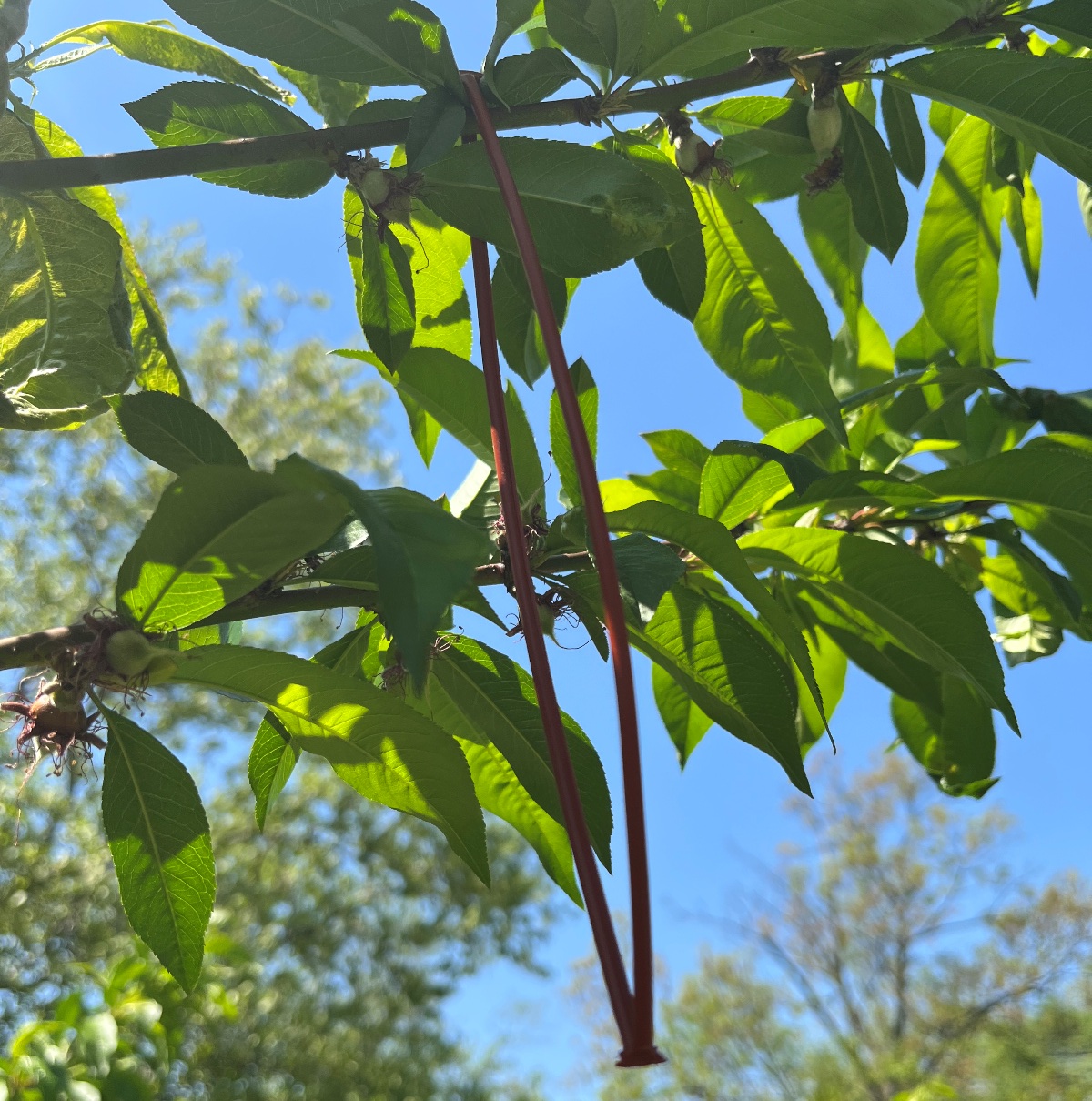
WHAT IS MATING DISRUPTION?
Mating disruption is when sex pheromones are released to prevent adult insects from finding each other and mating. This ultimately prevents the spread of pests. Pheromones are chemicals produced by an insect to communicate with others of the same species. There are different types of pheromones. The type of pheromone that mating disruptors interfere with are sex pheromones, which are chemicals released by insects to attract partners from long distances to mate. What happens is the orchard is flooded with artificially produced pheromones so that it is challenging for the insects to find each other. If they don’t find each other, they don’t mate, and if they don’t mate there are no eggs, no larvae, and less fruit damage!
Mating disruption works in a few ways. Some dispensers– the vessel containing pheromones– mimics a mating adult, attracting a partner to many false sources. Another method is the release of so much pheromones that it obscures the odor from an actual mating insect while also causing confusion in normal communication between them.
Another common component of mating disruption programs is the use of pheromone traps, also called monitoring traps. These are placed around the orchard early spring and are used as a tool to monitor pest populations and to know what pests to target before mating disruption dispensers (or other means of control) are deployed in the orchard.
Mating disruption techniques are currently most successful on moth species. Among common orchard pests, this includes Oriental Fruit Moth, Codling Moth, and Peach Borers.
MATING DISRUPTION PRODUCTS
In the beginning of a mating disruption program, pheromone lures are typically placed inside sticky pheromone traps to allow for pest monitoring. This is to track what pests live in your orchard to help inform what type of pheromones to release later on. These traps come in many forms, including bottle traps, delta traps, and funnel traps.
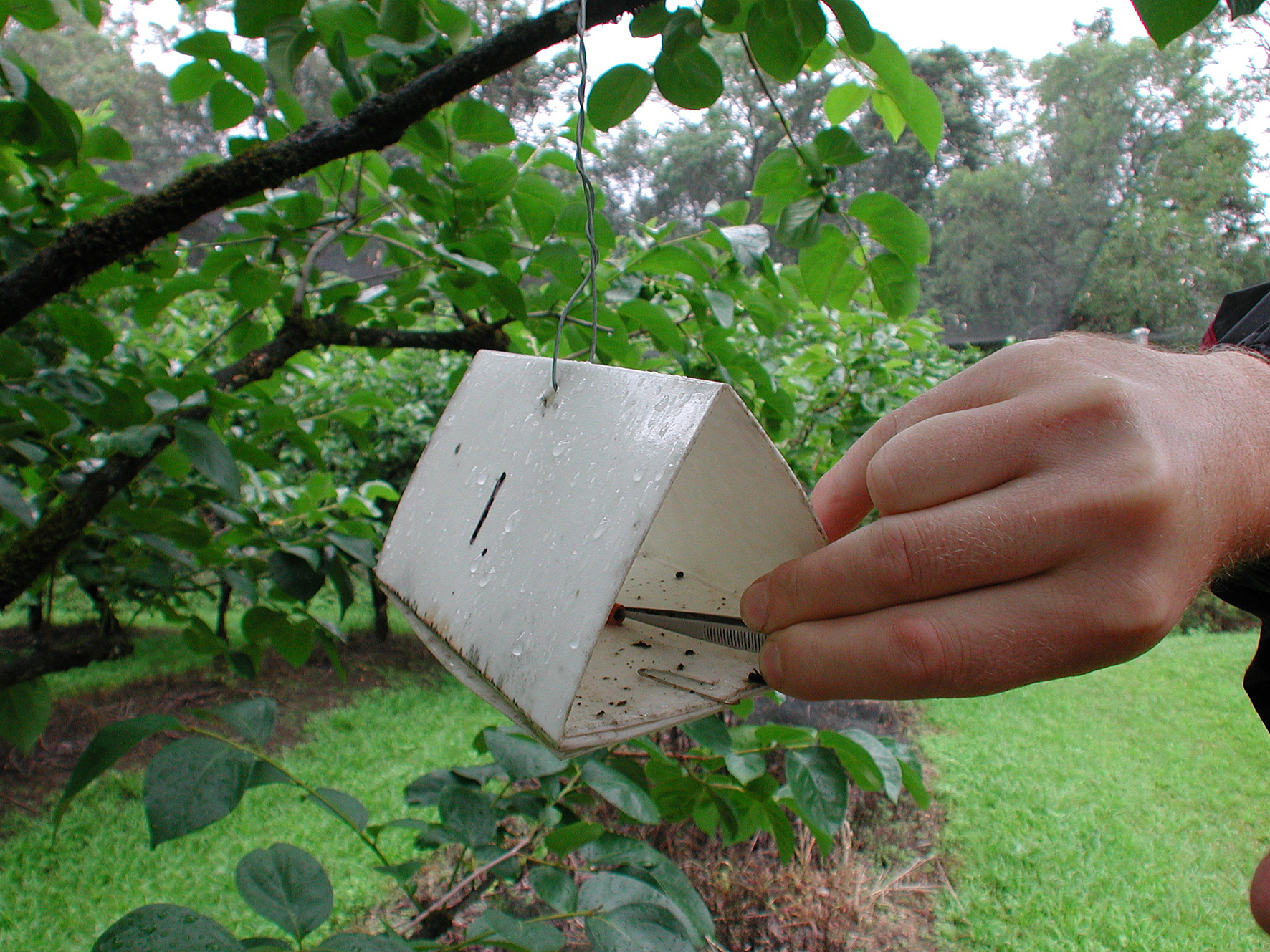
Source: David McClenaghan on Wikimedia Commons
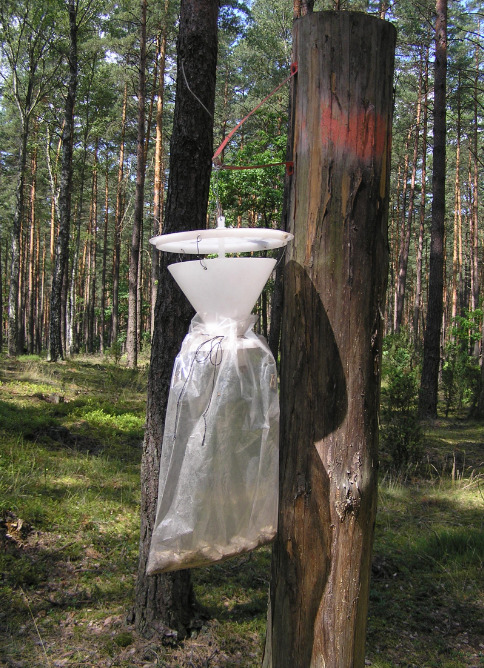
Source: Wikimedia Commons
There are different types of mating disruption dispensers. What they all do is emit artificial sex hormones and inundate the orchard with female pheromones. All of the products carry a small amount of a species’ pheromone in some type of dispenser.
Several types of dispensers have been used in mating disruption tests. These include rubber tubing, plastic wafers, twist ties, hollow fibers, clips, and sprays (still being developed). Most of them are designed to release pheromones slowly over time. There are currently around 15 new mating disruption products in research and development trials right now, so there are more to come! Sprayable pheromones are a new area that is still being developed, which is exciting because it is an easier option for growers versus going out and hanging up dispensers one by one.
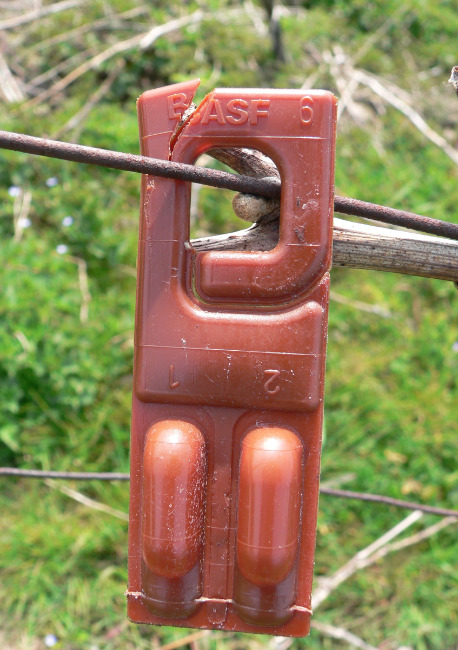
Source: Wikimedia Commons
HOW TO USE THEM
When starting a new mating disruption program, it is helpful to first know the initial pest population level. Using sticky pheromone traps (monitoring traps) for at least one previous season to determine general pest levels is key for knowing what pest to target, although if you know you’re losing a lot of fruit to OFM and codling moth, this ay not be necessary! For the first two years of a mating disruption program, it is generally recommended to also use other IPM methods at the same time to bring pest population levels down. Very early in the spring (February), hang at least one pheromone trap per 5 acres. They should be checked at least twice a week and cleaned out each week. Record the trapped insects. Traps and pheromone lures are replaced as necessary. Penn State Extension has trap data from the past few years for prominent pests that can be helpful in planning on when to place traps.
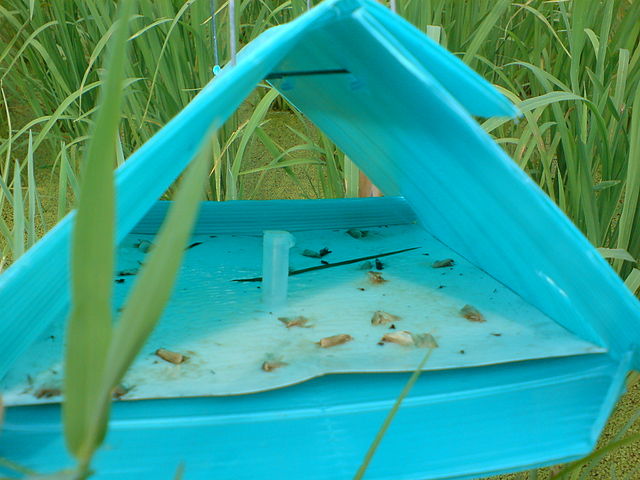
Source: Wikimedia Commons
It is good to plan ahead and have a season-long monitoring program personally designed before the season begins. Before you begin a mating disruption program, make sure you: 1) have time for pest scouting once a week; and 2) have a way of identifying pests and the damage they cause.
This will happen in early spring (March) but might vary slightly depending on what species you are targeting. Most dispensers are species-specific and target just one pest species, although some are now available that target both OFM and codling moth. The dispensers are hung individually on branches or posts and usually placed evenly throughout the orchard by hand, ranging from 150 to 400 per acre. They should be hung on the upper third of the tree canopy. It’s especially important to hang them on the borders of the orchard. Choose sturdy branches for hanging so that dispensers don’t fall off during high winds. The dispensers must be reapplied each spring with a new batch of fresh dispensers. If you have extra or leftover dispensers, you can store them in the freezer for up to one year. As the pest populations decline, there is the option of lowering the application rate to save costs, though you still want a higher application rate on the borders of the orchard.
If using sprayable pheromones, they last up to 4 to 6 weeks, therefore must be reapplied several times in a season for a target pest. Make sure to not spray before rainfall, because its potency will be reduced. Currently, the sprays are only able to control Oriental Fruit Moth.
BENEFITS
This method comes with many benefits. Though mating disruption doesn’t fully eradicate the pest problem, it can reduce the populations enough so as to mitigate the use of more harmful methods, like pesticides. This strategy has typically reduced pesticide use by at least 50%. The use of mating disruption can also hold pesticide resistance at bay, an increasing issue at many farms and orchards, since less pesticides need to be used alongside mating disruption.
The use of pheromones is healthier for humans, wildlife, and the environment. Because pheromones are not applied directly to the fruit, there are no residues left on the fruit. There is also no ill effect on the groundwater, soil, and air quality.
This method can lower the local population over time only if the pest is not highly mobile. If the pest can travel far and wide, locally lowered populations will likely be replenished from nearby sources and this method won’t be as effective.
It is a highly selective tool for the targeted pest species. This means it doesn’t cause harm to non-target species, a big benefit to using this method! It’s always a shame when a method that is used to suppress one problem creates a new problem, so luckily that is not the case here with pheromone disruption techniques.
THINGS TO CONSIDER
Mating disruption is not a guarantee for every insect that communicates via pheromones, so knowing what pest you are targeting is important so that you can look up whether this method is effective for that specific pest. Again, the primary orchard pests for which mating disruption is currently available include Oriental Fruit Moth, Codling Moth, and Peach Borers. The size and location of your orchard will determine the success of the mating disruption method. According to research, this method is most reliable in orchards of 5 acres or more. It will also not work well if there are other orchards nearby that aren’t being disrupted with this method, which is why it’s always important to hang dispensers on the perimeter of the growing space. POP has been experimenting with mating disrupters in smaller orchards, with some anecdotal success, but we’d like to see more research on this smaller scale application.
Mating disruption alone is typically not adequate to fully eradicate high pest populations. If the pest population is very high, mating can still occur despite the use of sex pheromones. It is mostly intended to keep pest populations lower. This shouldn’t be viewed as stand-alone strategy, but rather as one tactic used alongside other pest management strategies.
REFERENCES
WSU Tree Fruit: https://treefruit.wsu.edu/crop-protection/opm/mating-disruption/
Orchard IPM: https://extension.psu.edu/orchard-ipm-using-pheromones-for-monitoring-and-mating-disruption
Penn State Extension Trap Data: https://agsci.psu.edu/research/centers-facilities/extension/frec/growing-season-information/pheromone-traps
The Disruption Eruption: https://www.goodfruit.com/good-to-know-the-disruption-eruption/
Mating Disruption and Oriental Fruit Moth: https://ipm.ucanr.edu/agriculture/peach/oriental-fruit-moth/
SOURCES
https://www.arbico-organics.com/category/s?keyword=nomate
https://www.knowde.com/stores/suterra/products/checkmate-ofm-dispenser
https://www.iscatech.com/solutions/mating-disruption/
This POP Blog was written by Orchard Assistant Simone Shemshedini with help from Co-Executive Director Phil Forsyth.
SUPPORT US! If you found this entry useful, informative, or inspiring, please consider a donation of any size to help POP in planting and supporting community orchards in Philadelphia: phillyorchards.org/donate